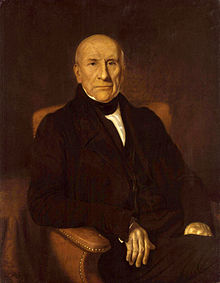Sir John Gladstone, 1st Baronet
|
Sir John Gladstone Bt FRSE |
|
|---|---|
 |
|
|
Member of Parliament for Berwick-upon-Tweed |
|
|
In office 1826–1827 |
|
| Preceded by | Sir Francis Blake, Bt |
| Succeeded by | Sir Francis Blake, Bt |
|
Member of Parliament for |
|
|
In office 1820–1826 |
|
| Preceded by | Sir Henry Dashwood, Bt |
| Succeeded by | George Spencer-Churchill, Marquess of Blandford |
|
Member of Parliament for Lancaster |
|
|
In office 1818–1820 |
|
| Preceded by | John Fenton-Cawthorne |
| Succeeded by | John Fenton-Cawthorne |
| Personal details | |
| Born |
11 December 1764 Leith, Midlothian, Scotland, Kingdom of Great Britain |
| Died | 7 December 1851 (aged 86) Fasque House, Kincardineshire, Scotland, UK |
| Resting place | St Andrew's Chapel, Kincardineshire, Scotland |
| Political party | Tory |
| Spouse(s) | Jane Hall (m. 1792–1798); Anne MacKenzie Robertson (m. 1801–1835) |
| Children |
|
| Profession | Merchant |
Sir John Gladstone of Fasque, 1st Baronet, FRSE LLD (11 December 1764 – 7 December 1851) was a Scottish merchant, slave-trader, Member of Parliament, and the father of the British Prime Minister William Ewart Gladstone. Through his commercial activities he acquired several large plantations in Jamaica and Guyana, worked initially by enslaved Africans. As a result of the Slavery Abolition Act 1833 which abolished slavery in the British Empire, Gladstone expelled most African workers from his estates and imported large numbers of indebted Indian indentured-servants, through false promises of providing them schools and medical attention. However, upon arrival they were paid no wages, the repayment of their debts being deemed sufficient, and worked under conditions that continued to resemble slavery in everything except name. Active in politics he worked to secure compensation from the British Government for "property losses" (in this case slaves) incurred as a result of the Slavery Abolition Act 1833 and eventually received £106,769 (modern equivalent £83m), the largest of all compensation payments made by the Slave Compensation Commission.
Born on King Street in Leith, Leith then being an independent burgh adjacent to Edinburgh, now a suburb of Edinburgh, John Gladstones was the eldest son of the merchant Thomas Gladstones, and his wife, Helen Neilson. They lived on Coalhill, at the south end of the Shore, Leith. John was the second of the family's sixteen children. John Gladstones left school in 1777 at the age of 13, later describing his education as "a very plain one - to read English, a little Latin, writing and figures comprehending the whole." John was apprenticed to Alexander Ogilvy, manager of the Edinburgh Roperie and Sailcloth Company ropeworks in Leith. On completing his apprenticeship in 1781, he entered his father's corn and grain trading and provisioning business.
...
Wikipedia
